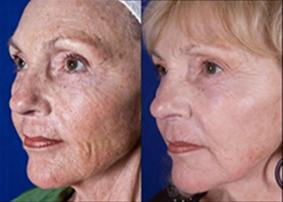With the background of normal skin anatomy in place, let’s turn our attention to what happens in the skin layers when marked visible signs of aging present themselves. What are the differences when we look at the skin of a young person and compare it to the skin layers associated with fine lines, wrinkles, furrows, sagging, discoloration, and dark circles? Changes characteristic of the aging process shift into high gear when skin is influenced by various factors, ultraviolet sunlight exposure being only one of them.
The sun-induced aging process, called photoaging, and an unchecked biological aging of the skin (supplemented with stress, a poor diet, and smoking) will both give you the same older-looking face. While some differences exist between photoaging and unbridled biologically aged skin, the differences are really a matter of semantics. For example, the epidermis in photoaging may be thicker because it is crusted and malformed. However, it has also been known to thin out in the manner characteristic of biological skin aging. Both photoaging and biological aging affect the skin to create visible aging.
A breakdown in the stratum corneum is characteristic of the skin-aging process and results in greater water loss and dehydration in aged skin. Another big change in aged skin is the flattening of rete ridges—the interlocking finger-like projections between the epidermis and dermis. When the ridges flatten out, surface area is lost and blood flow to the region declines considerably. This is especially bad because the aging process already causes diminished volume of blood delivered by the blood vessels.

The overall decrease in blood flow ultimately translates to a decline in important antioxidant and anti-inflammatory nutrients, and the removal of metabolic waste also declines. Like an appliance company that brings you the new washer and dryer and hauls away the old rusty ones, your blood delivers new nutrients and hauls away the junk. But your blood can only perform this service if it can gain access to the residence, in this case, your skin cells.
Within the aging dermis is a disorganization of collagen fibers, and while overall elastic tissue may increase, its structure is discombobulated. When the scaffolding of any structure starts to become disorganized, it loses stability and things crumble. In the case of aging skin, the propensity to wrinkle and sag is greatly enhanced when the skin’s structure becomes disorganized. While most scientific attention regarding aged dermis focuses on collagen and elastin, there is also a noticeable loss of those important GAGs (glycosaminoglycans).
Loss of bone integrity, muscle mass, and subcutaneous fat all contribute to the appearance of visible signs of aging. All of these structures lie below the epidermis and dermis, so you might not immediately think of them as part of the problem. Yet they add to the picture of aging by taking away the “fullness” and definition of facial structure. Osteoporosis experts have noted that loss of facial bone mass is an underappreciated cause of an older appearance, as compared to adults who maintain healthy bones. Young adults have an even distribution of fat tissue. The aging process enhances the likelihood of “pocket” accumulation of facial fat. Throw in a chaser of gravitational force on these cordoned-off areas of fat, and a droop, sag, and jowl is born.
